The power ring rolling machine market stands at the threshold of a decade-long expansion trajectory that promises to reshape metal forming technology and industrial manufacturing solutions. The market's journey from USD 1.2 billion in 2025 to USD 1.7 billion by 2035 represents substantial growth, demonstrating the accelerating adoption of advanced ring rolling technology and manufacturing optimization across steel forging operations, aerospace applications, and bearing manufacturing facilities.
The first half of the decade (2025 to 2030) will witness the market climbing from USD 1.2 billion to approximately USD 1,413.5 million, adding USD 213.5 million in value, which constitutes 42% of the total forecast growth period. This phase will be characterized by the rapid adoption of radial-axial rolling systems, driven by increasing precision manufacturing requirements and the growing need for advanced metal forming solutions worldwide. Enhanced automation capabilities and computer-controlled processing systems will become standard expectations rather than premium options.
The latter half (2030 to 2035) will witness continued growth from USD 1,413.5 million to USD 1.7 billion, representing an addition of USD 295.6 million or 58% of the decade's expansion. This period will be defined by mass market penetration of advanced ring rolling technologies, integration with comprehensive manufacturing platforms, and seamless compatibility with existing forging infrastructure. The market trajectory signals fundamental shifts in how manufacturing facilities approach metal forming and precision production, with participants positioned to benefit from growing demand across multiple machine types and application segments.
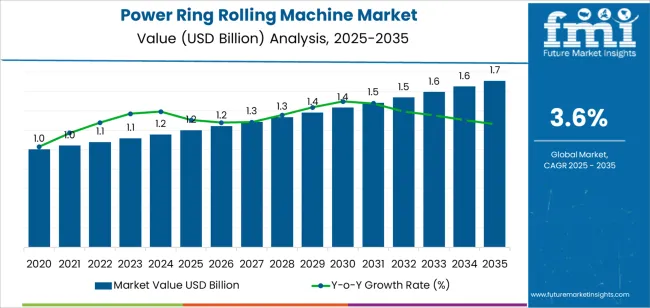
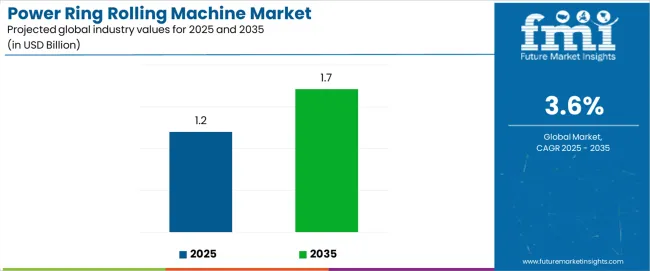
| Period | Primary Revenue Buckets | Share | Notes |
|---|---|---|---|
| Today | Radial-axial systems | 42% | Volume-driven, precision applications |
| Hydraulic ring rolling | 28% | Industrial focus, heavy-duty operations | |
| CNC ring expanders | 18% | Technology applications, automated processing | |
| Ancillary handling/heating | 12% | Support systems, auxiliary equipment | |
| Future (3-5 yrs) | Advanced radial-axial | 40-44% | Technology enhancement, precision optimization |
| Smart hydraulic systems | 26-30% | Automation improvement, efficiency positioning | |
| Enhanced CNC solutions | 17-21% | Digital integration, smart manufacturing | |
| Integrated handling systems | 11-15% | Complete solutions, process automation |
At-a-Glance Metrics
| Metric | Value |
|---|---|
| Market Value (2025) | USD 1.2 billion |
| Market Forecast (2035) | USD 1.7 billion |
| Growth Rate | 3.6% CAGR |
| Leading Product | Radial-Axial Systems |
| Primary Application | Steel Forges Segment |
The market demonstrates strong fundamentals with radial-axial systems capturing a dominant 42.0% share through advanced precision capabilities and manufacturing optimization. Steel forges applications drive primary demand with 38.0% market share, supported by increasing metal forming requirements and industrial manufacturing programs. Geographic expansion remains concentrated in developed markets with established heavy industry infrastructure, while emerging economies show accelerating adoption rates driven by manufacturing initiatives and rising production standards.
Primary Classification: The market segments by machine type into radial-axial, hydraulic ring rolling, CNC ring expanders, and ancillary handling/heating variants, representing the evolution from basic metal forming to specialized manufacturing solutions for comprehensive ring production and industrial optimization.
Secondary Classification: Workpiece segmentation divides the market into bearing rings (30.0%), aerospace rings (28.0%), flanges & pipes (22.0%), and gears/other (20.0%) categories, reflecting distinct requirements for precision performance, quality standards, and manufacturing capabilities.
Capacity Classification: Capacity segmentation covers 2-5 MN (34.0%), 5-10 MN (30.0%), and <2 MN and >10 MN (18.0% each) categories, addressing different production requirements from light-duty operations to heavy industrial applications.
Buyer Classification: Buyer segmentation addresses steel forges (38.0%), aero/defense (24.0%), bearing OEMs (20.0%), and oil & gas/power (18.0%) sectors, reflecting different manufacturing requirements and industrial specialization needs.
The segmentation structure reveals technology progression from standard metal forming toward specialized manufacturing systems with enhanced precision consistency and automation capabilities, while application diversity spans from steel production to aerospace manufacturing requiring precise forming solutions.
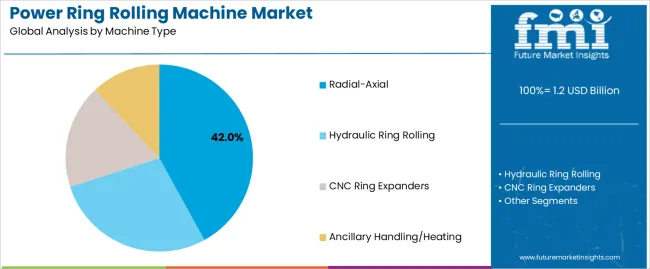
Market Position: Radial-axial systems command the leading position in the power ring rolling machine market with 42.0% market share through advanced manufacturing characteristics, including superior precision performance, process optimization, and industrial compatibility that enable manufacturers to achieve optimal ring quality across diverse bearing and aerospace applications.
Value Drivers: The segment benefits from manufacturer preference for reliable rolling systems that provide consistent forming performance, reduced setup complexity, and production optimization without requiring significant infrastructure modifications. Advanced precision features enable automated processing systems, dimensional control, and integration with existing manufacturing equipment, where operational performance and quality compliance represent critical production requirements.
Competitive Advantages: Radial-axial systems differentiate through proven manufacturing reliability, consistent forming characteristics, and integration with automated production systems that enhance manufacturing effectiveness while maintaining optimal quality standards for diverse industrial and aerospace applications.
Key market characteristics:
Hydraulic ring rolling maintains a 28.0% market position in the power ring rolling machine market due to their proven heavy-duty capabilities and industrial manufacturing characteristics. These systems appeal to facilities requiring high-force performance with targeted positioning for steel forging and heavy industrial applications. Market growth is driven by industrial segment expansion, emphasizing reliable forming solutions and production optimization through proven hydraulic technologies.
CNC ring expanders account for 18.0% market share, serving automated manufacturing applications requiring precision control performance and advanced processing characteristics for technology-focused production requirements.
Ancillary handling/heating systems capture 12.0% market share, focusing on process support applications, material handling, and operations requiring efficient auxiliary solutions for production optimization and workflow enhancement.
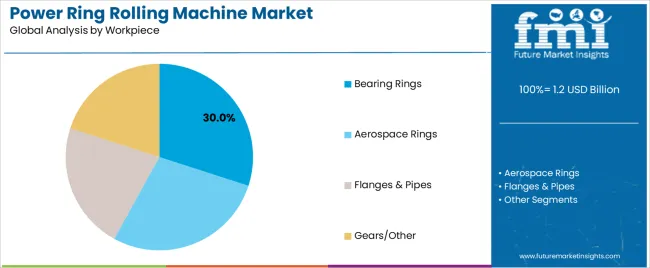
Market Context: Bearing rings applications demonstrate market leadership in the power ring rolling machine market with 30.0% share due to widespread adoption of precision manufacturing systems and increasing focus on dimensional accuracy, quality optimization, and performance enhancement that maximize bearing performance while maintaining precision standards.
Appeal Factors: Bearing manufacturers prioritize rolling precision, dimensional efficiency, and integration with existing production infrastructure that enables coordinated manufacturing operations across multiple production systems. The segment benefits from substantial bearing industry investment and modernization programs that emphasize the acquisition of advanced rolling systems for quality optimization and precision manufacturing applications.
Growth Drivers: Bearing production programs incorporate ring rolling as standard components for manufacturing operations, while automotive development growth increases demand for consistent precision capabilities that comply with quality standards and minimize production costs.
Application dynamics include:
Aerospace rings applications capture 28.0% market share through comprehensive precision requirements in aircraft component projects, aerospace manufacturing operations, and high-performance ring production. These applications demand reliable ring rolling systems capable of operating with extreme precision while providing effective dimensional integration and performance capabilities.
Flanges & pipes applications account for 22.0% market share, while gears/other applications capture 20.0% market share, including industrial components, specialized rings, and operations requiring efficient rolling solutions for manufacturing optimization and quality enhancement.
The 2-5 MN capacity segment commands 34.0% market share through widespread adoption in medium-scale manufacturing applications, standard production operations, and industrial projects. These machines provide optimal force solutions for diverse manufacturing requirements while maintaining operational flexibility and production reliability.
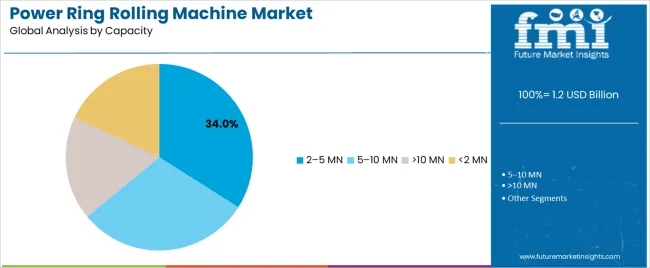
5-10 MN capacity applications capture 30.0% market share, serving heavy industrial operations, large-scale manufacturing, and facilities requiring enhanced force capabilities for heavy-duty production optimization and industrial efficiency.
<2 MN and >10 MN capacity applications each account for 18.0% market share, addressing light-duty and ultra-heavy production requirements respectively, with specialized manufacturing needs for precision or extreme force applications.
The steel forges segment commands 38.0% market share through widespread adoption in metal forming applications, steel production operations, and forging projects. These operations provide advanced manufacturing solutions for complex steel processing requirements while maintaining operational flexibility and quality reliability.
Aero/defense applications capture 24.0% market share, serving aerospace manufacturing, defense contractors, and facilities requiring enhanced precision capabilities for critical component production optimization and quality assurance.
Bearing OEMs applications account for 20.0% market share, while oil & gas/power applications capture 18.0% market share, addressing specialized manufacturing requirements and energy sector operations requiring unique rolling capabilities for component production.
| Category | Factor | Impact | Why It Matters |
|---|---|---|---|
| Driver | Industrial manufacturing growth & precision requirements (automotive bearings, aerospace components) | ★★★★★ | Large-scale manufacturing sectors require efficient, high-performance rolling solutions with consistent quality and precision integration across production applications. |
| Driver | Automation advancement & smart manufacturing (Industry 4.0, digital integration) | ★★★★★ | Drives demand for efficient rolling solutions and automation-compliant capabilities; suppliers providing digital features gain competitive advantage. |
| Driver | Quality standards & precision demands (aerospace specifications, bearing tolerances) | ★★★★☆ | Manufacturers need advanced, precise rolling solutions; demand for quality features expanding addressable market segments. |
| Restraint | High equipment costs & capital intensity | ★★★★☆ | Small manufacturers face cost pressure; increases price sensitivity and affects adoption in cost-sensitive segments with limited capital budgets. |
| Restraint | Skilled operator requirements & technical complexity | ★★★☆☆ | Precision-focused operations face challenges with operator training and specialized technical requirements, limiting adoption in resource-constrained segments. |
| Trend | Smart manufacturing integration & predictive maintenance | ★★★★★ | Growing demand for intelligent rolling solutions; predictive capabilities become core value proposition in advanced manufacturing segments. |
| Trend | Aerospace industry expansion & defense spending | ★★★★☆ | Regional development drives demand for precision rolling solutions; aerospace capabilities drive competition toward specialization. |
The power ring rolling machine market demonstrates varied regional dynamics with growth leaders including China (4.8% growth rate) and Brazil (4.4% growth rate) driving expansion through industrial modernization and manufacturing development. Strong Performers encompass USA (3.3% growth rate), UK (3.3% growth rate), and Germany (3.2% growth rate), benefiting from established heavy industry standards and advanced manufacturing adoption. Mature Markets feature South Korea (2.8% growth rate) and Japan (2.1% growth rate), where precision manufacturing development and quality standardization requirements support consistent growth patterns.
Regional synthesis reveals Asian markets leading adoption through industrial expansion and manufacturing modernization development, while Western countries maintain steady expansion supported by technological advancement and precision requirements. Emerging markets show strong growth driven by industrial manufacturing applications and automation integration trends.
| Region/Country | 2025 to 2035 Growth | How to win | What to watch out |
|---|---|---|---|
| China | 4.8% | Focus on industrial-scale manufacturing solutions | Local competition; technology transfer requirements |
| Brazil | 4.4% | Lead with cost-effective industrial models | Economic dependencies; infrastructure limitations |
| USA | 3.3% | Value-oriented precision models | Market maturity; aerospace regulations |
| UK | 3.3% | Offer advanced manufacturing systems | Market maturity; industrial regulations |
| Germany | 3.2% | Provide premium engineering integration | Over-engineering; regulatory compliance |
| South Korea | 2.8% | Push industrial automation applications | Technology costs; domestic competition |
| Japan | 2.1% | Premium precision positioning | Market maturity; quality requirements |
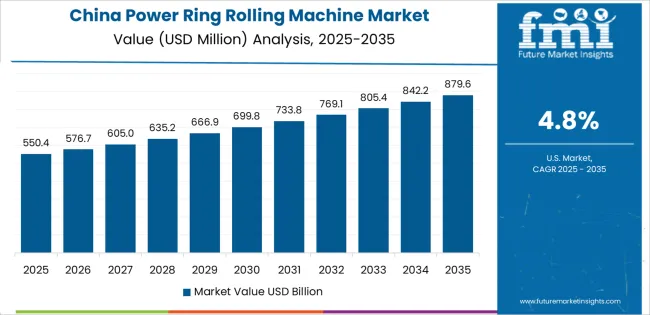
China establishes fastest market growth through aggressive industrial modernization programs and comprehensive manufacturing development, integrating advanced power ring rolling machine systems as standard components in steel production, bearing manufacturing, and aerospace applications. The country's 4.8% growth rate reflects government initiatives promoting industrial upgrading and manufacturing development capabilities that mandate the use of advanced forming systems in production projects. Growth concentrates in major industrial centers, including Jiangsu, Shandong, and Hebei, where manufacturing technology development showcases integrated ring rolling systems that appeal to manufacturers seeking advanced production optimization capabilities and quality management applications.
Chinese manufacturers are developing industrial-focused ring rolling solutions that combine domestic manufacturing advantages with advanced forming features, including automation systems and enhanced precision capabilities. Distribution channels through industrial equipment suppliers and manufacturing service distributors expand market access, while government support for industrial development supports adoption across diverse manufacturing segments.
Strategic Market Indicators:
Power ring rolling machine market expansion benefits from diverse industrial development demand, including steel production growth in São Paulo and Minas Gerais, manufacturing upgrades, and industrial programs that increasingly incorporate power ring rolling systems for production optimization applications. The country maintains a 4.4% growth rate, driven by rising industrial consciousness and increasing recognition of advanced forming benefits, including enhanced manufacturing performance and improved production functionality.
Market dynamics focus on cost-effective ring rolling solutions that balance advanced manufacturing performance with affordability considerations important to Brazilian industrial operators. Growing industrial development creates continued demand for rolling systems in manufacturing infrastructure and production enhancement projects.
Strategic Market Indicators:
United States establishes advanced manufacturing integration through comprehensive industrial modernization and technology development, integrating power ring rolling machine systems across aerospace facilities and manufacturing operations. The country's 3.3% growth rate reflects mature industrial relationships and established manufacturing adoption that supports widespread use of rolling systems in aerospace and industrial facilities. Growth concentrates in major manufacturing centers, including Ohio, Michigan, and Texas, where industrial technology showcases mature ring rolling deployment that appeals to operators seeking proven manufacturing capabilities and precision efficiency applications.
American manufacturers leverage established distribution networks and comprehensive manufacturing capabilities, including system integration programs and technical support that create customer relationships and operational advantages. The market benefits from mature aerospace standards and manufacturing requirements that mandate rolling system use while supporting technology advancement and production optimization.
Strategic Market Indicators:
United Kingdom establishes manufacturing development through comprehensive industrial modernization and precision integration, integrating power ring rolling systems across aerospace and specialty manufacturing applications. The country's 3.3% growth rate reflects growing precision investment and increasing adoption of rolling technology that supports expanding use of advanced systems in British manufacturing facilities. Growth concentrates in major regions, including West Midlands, North West, and Yorkshire, where manufacturing technology development showcases integrated ring rolling systems that appeal to British operators seeking advanced manufacturing solutions with precision compatibility.
British manufacturers focus on maintaining quality standards while adopting manufacturing precision, creating demand for systems that balance performance with operational advantages. The market benefits from strong aerospace infrastructure and growing precision consciousness that support rolling technology adoption while maintaining quality standards important to British manufacturing applications.
Strategic Market Indicators:
Advanced manufacturing technology market in Germany demonstrates sophisticated power ring rolling machine system deployment with documented operational effectiveness in precision manufacturing applications and industrial projects through integration with existing production systems and manufacturing infrastructure. The country leverages engineering expertise in forming technology and manufacturing systems integration to maintain a 3.2% growth rate. Manufacturing centers, including North Rhine-Westphalia, Bavaria, and Baden-Württemberg, showcase premium installations where ring rolling systems integrate with comprehensive manufacturing platforms and quality management systems to optimize production operations and precision effectiveness.
German manufacturers prioritize system precision and EU compliance in forming development, creating demand for premium systems with advanced features, including quality monitoring integration and automated rolling systems. The market benefits from established manufacturing technology infrastructure and willingness to invest in advanced forming technologies that provide long-term operational benefits and compliance with international manufacturing standards.
Strategic Market Indicators:
South Korea establishes industrial innovation development through comprehensive manufacturing modernization and technology integration, integrating power ring rolling systems across production processing and specialty manufacturing applications. The country's 2.8% growth rate reflects growing innovation investment and increasing adoption of rolling technology that supports expanding use of advanced systems in Korean manufacturing facilities. Growth concentrates in major industrial areas, including Ulsan, Gyeonggi, and South Chungcheong, where manufacturing technology development showcases integrated ring rolling systems that appeal to Korean operators seeking advanced production solutions with automation compatibility.
Korean manufacturers focus on maintaining quality standards while adopting manufacturing automation, creating demand for systems that balance performance with technological advantages. The market benefits from strong industrial infrastructure and growing export opportunities that support rolling technology adoption while maintaining quality standards important to Korean manufacturing applications.
Strategic Market Indicators:
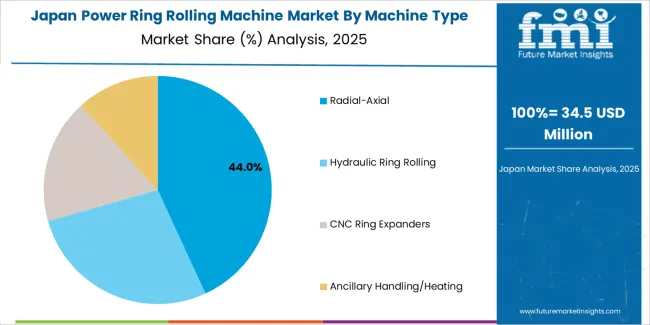
Advanced manufacturing technology market in Japan demonstrates sophisticated power ring rolling machine system deployment with documented operational effectiveness in premium precision applications and specialized manufacturing projects through integration with existing quality systems and production infrastructure. The country maintains a 2.1% growth rate, leveraging traditional precision expertise and quality systems integration in forming technology. Manufacturing centers, including Tokyo, Osaka, and Nagoya, showcase premium installations where ring rolling systems integrate with traditional quality platforms and modern production management systems to optimize manufacturing operations and maintain precision quality profiles.
Japanese manufacturers prioritize manufacturing precision and quality consistency in forming development, creating demand for premium systems with advanced features, including quality monitoring and automated manufacturing systems. The market benefits from established quality infrastructure and commitment to manufacturing standards that provide long-term operational benefits and compliance with traditional quality production methods.
Strategic Market Indicators:
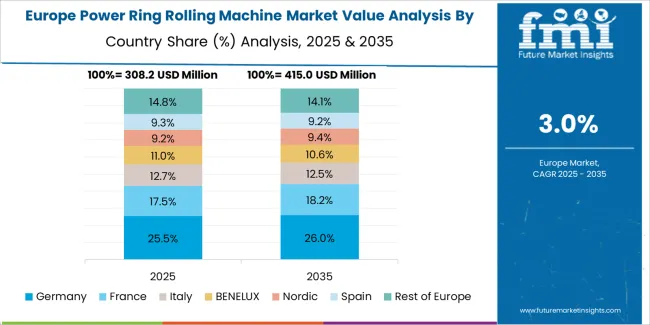
The power ring rolling machine market in Europe is projected to grow from USD 360.0 million in 2025 to USD 486.0 million by 2035, registering a CAGR of 3.1% over the forecast period. Germany is expected to maintain its leadership position with a 35.6% market share in 2025, growing to 36.2% by 2035, supported by its advanced manufacturing infrastructure and major industrial centers including North Rhine-Westphalia and Bavaria.
Italy follows with a 22.4% share in 2025, projected to reach 22.8% by 2035, driven by comprehensive steel production programs and manufacturing innovation development. United Kingdom holds a 18.3% share in 2025, expected to maintain 18.1% by 2035 despite market adjustments. France commands a 12.8% share, while Spain accounts for 10.9% in 2025. The Rest of Europe region is anticipated to gain momentum, maintaining its collective share at approximately 11.0% by 2035, attributed to increasing power ring rolling adoption in Nordic countries and emerging manufacturing facilities implementing precision-focused programs.
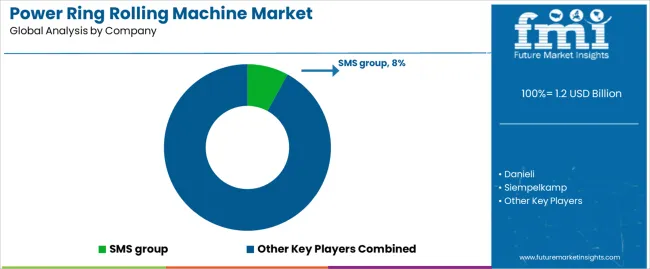
| Stakeholder | What they actually control | Typical strengths | Typical blind spots |
|---|---|---|---|
| Global platforms | Manufacturing reach, deep industrial catalogs, production facilities | Broad availability, proven reliability, multi-region projects | Technology refresh cycles; application dependency management |
| Technology innovators | R&D capabilities; advanced rolling systems; automation interfaces | Latest technology first; attractive ROI on large projects | Service density outside core regions; customization complexity |
| Regional specialists | Local sourcing, fast delivery, nearby manufacturing support | "Close to site" support; pragmatic pricing; local industrial codes | Technology gaps; talent retention in manufacturing engineering |
| Quality-focused ecosystems | Manufacturing consistency, technical support, precision sourcing | Lowest performance variation; comprehensive support | Implementation costs if overpromised; technology obsolescence |
| Application specialists | Specialized configurations, custom solutions, industrial development | Win specialized projects; flexible engineering | Scalability limitations; narrow market focus |
| Items | Values |
|---|---|
| Quantitative Units (2025) | USD 1,200.0 million |
| Machine Type | Radial-Axial, Hydraulic Ring Rolling, CNC Ring Expanders, Ancillary Handling/Heating |
| Workpiece | Bearing Rings, Aerospace Rings, Flanges & Pipes, Gears/Other |
| Capacity | <2 MN, 2–5 MN, 5–10 MN, >10 MN |
| Buyer | Steel Forges, Aero/Defense, Bearing OEMs, Oil & Gas/Power |
| Regions Covered | Asia Pacific, Europe, North America, South America, Middle East & Africa |
| Countries Covered | China, Germany, USA, United Kingdom, Japan, South Korea, Brazil, and 25+ additional countries |
| Key Companies Profiled | SMS group, Danieli, Siempelkamp, Schuler Group, Anyang Forging Press, Nanjing Zhongke, GFM Maschinenbau, Shanxi Daqiang |
| Additional Attributes | Dollar sales by machine type and workpiece categories, regional adoption trends across Asia Pacific, Europe, and North America, competitive landscape with equipment manufacturers and industrial suppliers, operator preferences for manufacturing consistency and precision reliability, integration with production platforms and quality management systems, innovations in ring rolling technology and manufacturing enhancement, and development of advanced forming solutions with enhanced performance and precision optimization capabilities. |
The global power ring rolling machine market is estimated to be valued at USD 1.2 billion in 2025.
The market size for the power ring rolling machine market is projected to reach USD 1.7 billion by 2035.
The power ring rolling machine market is expected to grow at a 3.6% CAGR between 2025 and 2035.
The key product types in power ring rolling machine market are radial-axial, hydraulic ring rolling, cnc ring expanders and ancillary handling/heating.
In terms of workpiece, bearing rings segment to command 30.0% share in the power ring rolling machine market in 2025.






Full Research Suite comprises of:
Market outlook & trends analysis
Interviews & case studies
Strategic recommendations
Vendor profiles & capabilities analysis
5-year forecasts
8 regions and 60+ country-level data splits
Market segment data splits
12 months of continuous data updates
DELIVERED AS:
PDF EXCEL ONLINE
Power Plant Boiler Market Size and Share Forecast Outlook 2025 to 2035
Power Electronics Market Size and Share Forecast Outlook 2025 to 2035
Power Quality Equipment Market Size and Share Forecast Outlook 2025 to 2035
Power Generator for Military Market Size and Share Forecast Outlook 2025 to 2035
Power Tools Market Size and Share Forecast Outlook 2025 to 2035
Power Supply Isolation Equipment Market Size and Share Forecast Outlook 2025 to 2035
Power Window Lift Motor Market Size and Share Forecast Outlook 2025 to 2035
Powered Surgical Staplers Market Size and Share Forecast Outlook 2025 to 2035
Power Distribution Component Market Size and Share Forecast Outlook 2025 to 2035
Power Over Ethernet (PoE) Controllers Market Size and Share Forecast Outlook 2025 to 2035
Power Inverter Market Size and Share Forecast Outlook 2025 to 2035
Power Sports Market Size and Share Forecast Outlook 2025 to 2035
Power Conditioner Market Size and Share Forecast Outlook 2025 to 2035
Power Control Commercial Surge Protection Devices Market Size and Share Forecast Outlook 2025 to 2035
Power Transmission Component Market Size and Share Forecast Outlook 2025 to 2035
Power Optimizer Market Size and Share Forecast Outlook 2025 to 2035
Power Plants Heavy Duty Gas Turbine Market Size and Share Forecast Outlook 2025 to 2035
Power Over Ethernet (PoE) Solutions Market Size and Share Forecast Outlook 2025 to 2035
Power Management System Market Analysis - Size, Share, and Forecast Outlook 2025 to 2035
Power Line Communication (PLC) Market Size and Share Forecast Outlook 2025 to 2035

Thank you!
You will receive an email from our Business Development Manager. Please be sure to check your SPAM/JUNK folder too.
Chat With
MaRIA